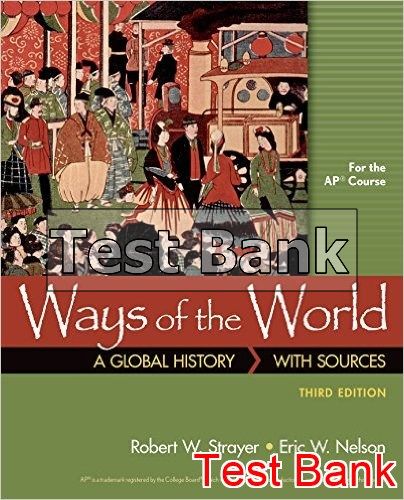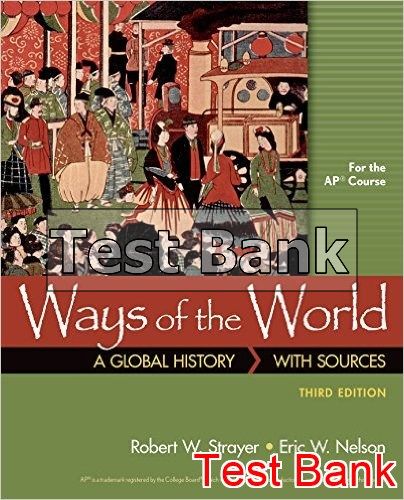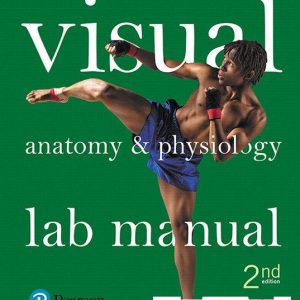This is completed downloadable of Ways of the World with Sources for AP 3rd Edition Strayer Test Bank

Product Details:
- ISBN-10 : 1319022723
- ISBN-13 : 978-1319022723
- Author:
Ways of the World is the ideal textbook for your redesigned AP® World History classroom. Like the AP® course it supports, Ways of the World focuses on significant historical trends, themes, and developments in world history. Authors Robert Strayer and Eric Nelson provide a thoughtful and insightful synthesis that helps students see the big picture. Each chapter then culminates with collections of primary sources organized around a particular theme, issue, or question, allowing students to consider the evidence the way historians do.
Table of Content:
- Part One First Things First: Beginnings in History, to 600 B.C.E.
- The Big Picture: Turning Points in Early World History
- The Emergence of Humankind
- The Globalization of Humankind
- The Revolution of Farming and Herding
- The Turning Point of Civilization
- Time and World History
- Landmarks in World History (to ca. 600 B.C.E.)
- Understanding AP® Themes in Part One
- 1 First Peoples; First Farmers: Most of History in a Single Chapter, to 4000 B.C.E.
- Out of Africa: First Migrations
- Into Eurasia
- Into Australia
- Into the Americas
- Into the Pacific
- The Ways We Were
- The First Human Societies
- Economy and the Environment
- The Realm of the Spirit
- Settling Down: The Great Transition
- Zooming In: Göbekli Tepe: Monumental Construction before Agriculture
- Breakthroughs to Agriculture
- Common Patterns
- Variations
- The Globalization of Agriculture
- Triumph and Resistance
- The Culture of Agriculture
- Zooming In: Ishi, the Last of His People
- Social Variation in the Age of Agriculture
- Pastoral Societies
- Agricultural Village Societies
- Chiefdoms
- Reflections: The Uses of the Paleolithic
- Chapter Review
- What’s the Significance?
- Big Picture Questions
- Next Steps: For Further Study
- Working with Evidence: Written Sources
- Stories of the Australian Dreamtime
- 1.1 Understanding Creation: Yhi Brings Life to the World
- 1.2 Understanding the Significance of Animals: The Platypus
- 1.3 Understanding Men and Women: The Man-Eater: The Mutjinga Myth
- 1.4 Understanding Death: How Death Came: The Purukapali Myth
- 2 First Civilizations: Cities, States, and Unequal Societies, 3500 B.C.E.–600 B.C.E.
- Something New: The Emergence of Civilizations
- Introducing the First Civilizations
- Zooming In: Caral, a City of Norte Chico
- The Question of Origins
- An Urban Revolution
- The Erosion of Equality
- Hierarchies of Class
- Hierarchies of Gender
- Patriarchy in Practice
- The Rise of the State
- Coercion and Consent
- Writing and Accounting
- The Grandeur of Kings
- Comparing Mesopotamia and Egypt
- Environment and Culture
- Cities and States
- Zooming In: Paneb, an Egyptian Troublemaker
- Interaction and Exchange
- Reflections: “Civilization”: What’s in a Word?
- Chapter Review
- What’s the Significance?
- Big Picture Questions
- Next Steps: For Further Study
- Working with Evidence: Visual Sources
- Indus Valley Civilization
- 2.1 A Seal from the Indus Valley
- 2.2 Man from Mohenjo Daro
- 2.3 Dancing Girl
- Part One AP® Exam Practice Questions
- Part Two Second-Wave Civilizations in World History, 600 B.C.E.–600 C.E.
- The Big Picture: After the First Civilizations: What Changed and What Didn’t?
- Continuities in Civilization
- Changes in Civilization
- Landmarks in World History (ca. 600 B.C.E.–ca. 600 C.E.)
- Understanding AP® Themes in Part Two
- 3 State and Empire in Eurasia/North Africa, 600 B.C.E.–600 C.E.
- Empires and Civilizations in Collision: The Persians and the Greeks
- The Persian Empire
- The Greeks
- Collision: The Greco-Persian Wars
- Collision: Alexander and the Hellenistic Era
- Comparing Empires: Roman and Chinese
- Rome: From City-State to Empire
- China: From Warring States to Empire
- Consolidating the Roman and Chinese Empires
- Zooming In: Trung Trac: Resisting the Chinese Empire
- The Collapse of Empires
- Zooming In: The Kushan Empire
- Intermittent Empire: The Case of India
- Reflections: Enduring Legacies of Second-Wave Empires
- Chapter Review
- What’s the Significance?
- Big Picture Questions
- Next Steps: For Further Study
- Working with Evidence: Written Sources
- Perceptions of Outsiders in the Ancient World
- 3.1 A Greek Historian on Persia and Egypt: Herodotus, The Histories, Mid-Fifth Century B.C.E.
- 3.2 A Roman Historian on the Germans: Tacitus, Germania, First Century C.E.
- 3.3 A Chinese Historian on the Xiongnu: Sima Qian, Records of the Grand Historian, ca. 100 B.C.E.
- 4 Culture and Religion in Eurasia/North Africa, 600 B.C.E.–600 C.E.
- China and the Search for Order
- The Legalist Answer
- The Confucian Answer
- The Daoist Answer
- Cultural Traditions of Classical India
- South Asian Religion: From Ritual Sacrifice to Philosophical Speculation
- The Buddhist Challenge
- Zooming In: Nalanda, India’s Buddhist University
- Hinduism as a Religion of Duty and Devotion
- Toward Monotheism: The Search for God in the Middle East
- Zoroastrianism
- Judaism
- The Cultural Tradition of Classical Greece: The Search for a Rational Order
- The Greek Way of Knowing
- The Greek Legacy
- The Birth of Christianity . . . with Buddhist Comparisons
- The Lives of the Founders
- The Spread of New Religions
- Zooming In: Perpetua, Christian Martyr
- Institutions, Controversies, and Divisions
- Reflections: Religion and Historians
- Chapter Review
- What’s the Significance?
- Big Picture Questions
- Next Steps: For Further Study
- Working with Evidence: Visual Sources
- Representations of the Buddha
- 4.1 Footprints of the Buddha
- 4.2 A Gandhara Buddha
- 4.3 A Bodhisattva of Compassion: Avalokitesvara with a Thousand Arms
- 4.4 The Chinese Maitreya Buddha
- 5 Society and Inequality in Eurasia/North Africa, 600 B.C.E.–600 C.E.
- Society and the State in China
- An Elite of Officials
- The Landlord Class
- Peasants
- Zooming In: Ge Hong, a Chinese Scholar in Troubled Times
- Merchants
- Class and Caste in India
- Caste as Varna
- Caste as Jati
- The Functions of Caste
- Slavery: The Case of the Roman Empire
- Slavery and Civilization
- The Making of Roman Slavery
- Zooming In: The Spartacus Slave Revolt
- Comparing Patriarchies
- A Changing Patriarchy: The Case of China
- Contrasting Patriarchies: Athens and Sparta
- Reflections: What Changes? What Persists?
- Chapter Review
- What’s the Significance?
- Big Picture Questions
- Next Steps: For Further Study
- Working with Evidence: Visual Sources
- Pompeii as a Window on the Roman World
- 5.1 Terentius Neo and His Wife
- 5.2 A Pompeii Banquet
- 5.3 Scenes in a Pompeii Tavern
- 5.4 A Domestic Shrine
- 5.5 Mystery Religions: The Cult of Dionysus
- 6 Commonalities and Variations: Africa, the Americas, and Pacific Oceania, 600 B.C.E.–1200 C.E.
- Continental Comparisons
- Civilizations of Africa
- Meroë: Continuing a Nile Valley Civilization
- Zooming In: Piye, Kushite Conqueror of Egypt
- Axum: The Making of a Christian Kingdom
- Along the Niger River: Cities without States
- Civilizations of Mesoamerica
- The Maya: Writing and Warfare
- Teotihuacán: The Americas’ Greatest City
- Civilizations of the Andes
- Chavín: A Pan-Andean Religious Movement
- Moche: A Civilization of the Coast
- Wari and Tiwanaku: Empires of the Interior
- Zooming In: The Lord of Sipan and the Lady of Cao
- Alternatives to Civilization
- Bantu Africa: Cultural Encounters and Social Variation
- North America: Ancestral Pueblo and Mound Builders
- Pacific Oceania: Peoples of the Sea
- Reflections: Deciding What’s Important: Balance in World History
- Chapter Review
- What’s the Significance?
- Big Picture Questions
- Next Steps: For Further Study
- Working with Evidence: Written Sources
- Axum and the World
- 6.1 A Guidebook to the World of Indian Ocean Commerce: The Periplus of the Erythraean Sea, First Century C.E.
- 6.2 The Making of an Axumite Empire: Inscription on a Stone Throne, Second or Third Century C.E.
- 6.3 The Coming of Christianity to Axum: Rufinus, On the Evangelization of Abyssinia, Late Fourth Century C.E.
- 6.4 Axum and the Gold Trade: Cosmas, The Christian Topography, Sixth Century C.E.
- Part Two AP® Exam Practice Questions
- Part Three An Age of Accelerating Connections, 600 C.E.–1450
- The Big Picture: Defining a Millennium
- Third-Wave Civilizations: Something New, Something Old, Something Blended
- The Ties That Bind: Transregional Interaction in the Third-Wave Era
- Landmarks in World History (600 C.E.–1450)
- Understanding AP® Themes in Part Three
- 7 Commerce and Culture, 600–1450
- Silk Roads: Exchange across Eurasia
- The Growth of the Silk Roads
- Goods in Transit
- Cultures in Transit
- Disease in Transit
- Sea Roads: Exchange across the Indian Ocean
- Weaving the Web of an Indian Ocean World
- Sea Roads as a Catalyst for Change: Southeast Asia
- Sea Roads as a Catalyst for Change: East Africa
- Sand Roads: Exchange across the Sahara
- Commercial Beginnings in West Africa
- Gold, Salt, and Slaves: Trade and Empire in West Africa
- Zooming In: The Arabian Camel
- An American Network: Commerce and Connection in the Western Hemisphere
- Zooming In: Thorfinn Karlsefni, Viking Voyager
- Reflections: Economic Globalization — Ancient and Modern
- Chapter Review
- What’s the Significance?
- Big Picture Questions
- Next Steps: For Further Study
- Working with Evidence: Written Sources
- Travelers’ Tales and Observations
- 7.1 A Chinese Buddhist in India: Huili, A Biography of the Tripitaka Master, Seventh Century C.E.; Xuanzang, Record of the Western Region, Seventh Century C.E.
- 7.2 A European Christian in China: Marco Polo, The Travels of Marco Polo, 1299
- 7.3 A Moroccan Diplomat in West Africa: Leo Africanus, The History and Description of Africa, 1526
- 8 China and the World: East Asian Connections, 600–1300
- Together Again: The Reemergence of a Unified China
- A “Golden Age” of Chinese Achievement
- Zooming In: Gunpowder
- Women in the Song Dynasty
- China and the Northern Nomads: A Chinese World Order in the Making
- The Tribute System in Theory
- The Tribute System in Practice
- Cultural Influence across an Ecological Frontier
- Coping with China: Comparing Korea, Vietnam, and Japan
- Korea and China
- Vietnam and China
- Japan and China
- Zooming In: Izumi Shikibu, Japanese Poet and Lover
- China and the Eurasian World Economy
- Spillovers: China’s Impact on Eurasia
- On the Receiving End: China as Economic Beneficiary
- China and Buddhism
- Making Buddhism Chinese
- Losing State Support: The Crisis of Chinese Buddhism
- Reflections: Why Do Things Change?
- Chapter Review
- What’s the Significance?
- Big Picture Questions
- Next Steps: For Further Study
- Working with Evidence: Visual Sources
- The Leisure Life of China’s Elites
- 8.1 A Banquet with the Emperor
- 8.2 At Table with the Empress
- 8.3 A Literary Gathering
- 8.4 An Elite Night Party
- 9 The Worlds of Islam: Afro-Eurasian Connections, 600–1450
- The Birth of a New Religion
- The Homeland of Islam
- The Messenger and the Message
- The Transformation of Arabia
- The Making of an Arab Empire
- War, Conquest, and Tolerance
- Conversion
- Divisions and Controversies
- Zooming In: Mullah Nasruddin, the Wise Fool of Islam
- Women and Men in Early Islam
- Islam and Cultural Encounter: A Four-Way Comparison
- The Case of India
- The Case of Anatolia
- The Case of West Africa
- The Case of Spain
- Zooming In: Mansa Musa, West African Monarch and Muslim Pilgrim
- The World of Islam as a New Civilization
- Networks of Faith
- Networks of Exchange
- Reflections: Past and Present: Choosing Our History
- Chapter Review
- What’s the Significance?
- Big Picture Questions
- Next Steps: For Further Study
- Working with Evidence: Visual Sources
- The Life of the Prophet
- 9.1 Muhammad and the Archangel Gabriel
- 9.2 The Night Journey of Muhammad
- 9.3 The Battle at Badr
- 9.4 The Destruction of the Idols
- 10 The Worlds of Christendom: Contraction, Expansion, and Division, 600–1300
- Christian Contraction in Asia and Africa
- Asian Christianity
- African Christianity
- Byzantine Christendom: Building on the Roman Past
- The Byzantine State
- The Byzantine Church and Christian Divergence
- Byzantium and the World
- The Conversion of Russia
- Zooming In: 988 and the Conversion of Rus
- Western Christendom: Rebuilding in the Wake of Roman Collapse
- Political Life in Western Europe
- Society and the Church
- Accelerating Change in the West
- Zooming In: Cecilia Penifader, an English Peasant and Unmarried Woman
- Europe Outward Bound: The Crusading Tradition
- The West in Comparative Perspective
- Catching Up
- Pluralism in Politics
- Reason and Faith
- Reflections: Remembering and Forgetting: Continuity and Surprise in the Worlds of Christendom
- Chapter Review
- What’s the Significance?
- Big Picture Questions
- Next Steps: For Further Study
- Working with Evidence: Written Sources
- The Making of Christian Europe
- 10.1 The Conversion of Clovis: Gregory of Tours, History of the Franks, Late Sixth Century
- 10.2 Advice on Dealing with “Pagans”: Pope Gregory, Advice to the English Church, 601
- 10.3 Charlemagne and the Saxons: Charlemagne, Capitulary on Saxony, 785
- 10.4 The Persistence of Tradition: Willibald, Life of Boniface, ca. 760
- 10.5 The Persistence of Tradition: Leechbook, Tenth Century
- 11 Pastoral Peoples on the Global Stage: The Mongol Moment, 1200–1450
- Looking Back and Looking Around: The Long History of Pastoral Peoples
- The World of Pastoral Societies
- Before the Mongols: Pastoralists in History
- Breakout: The Mongol Empire
- From Temujin to Chinggis Khan: The Rise of the Mongol Empire
- Explaining the Mongol Moment
- Zooming In: A Mongol Failure: The Invasion of Japan
- Encountering the Mongols: Comparing Three Cases
- China and the Mongols
- Persia and the Mongols
- Zooming In: Khutulun, a Mongol Wrestler Princess
- Russia and the Mongols
- The Mongol Empire as a Eurasian Network
- Toward a World Economy
- Diplomacy on a Eurasian Scale
- Cultural Exchange in the Mongol Realm
- The Plague: An Afro-Eurasian Pandemic
- Reflections: Changing Images of Pastoral Peoples
- Chapter Review
- What’s the Significance?
- Big Picture Questions
- Next Steps: For Further Study
- Working with Evidence: Written Sources
- Perspectives on the Mongols
- 11.1 Mongol History from a Mongol Source: The Secret History of the Mongols, ca. 1240
- 11.2 Chinggis Khan and Changchun: Chinggis Khan, Letter to Changchun, 1219
- 11.3 The Conquest of Bukhara: A Persian View: Juvaini, The History of the World Conqueror, 1219
- 11.4 A Russian View of the Mongols: The Chronicle of Novgorod, 1238
- 11.5 Mongol Women through European Eyes: William of Rubruck, Journey to the Land of the Mongols, ca. 1255
- 12 The Worlds of the Fifteenth Century
- The Shapes of Human Communities
- Paleolithic Persistence: Australia and North America
- Agricultural Village Societies: The Igbo and the Iroquois
- Pastoral Peoples: Central Asia and West Africa
- Civilizations of the Fifteenth Century: Comparing China and Europe
- Ming Dynasty China
- Zooming In: Zheng He, China’s Non-Chinese Admiral
- European Comparisons: State Building and Cultural Renewal
- European Comparisons: Maritime Voyaging
- Civilizations of the Fifteenth Century: The Islamic World
- In the Islamic Heartland: The Ottoman and Safavid Empires
- Zooming In: 1453 in Constantinople
- On the Frontiers of Islam: The Songhay and Mughal Empires
- Civilizations of the Fifteenth Century: The Americas
- The Aztec Empire
- The Inca Empire
- Webs of Connection
- A Preview of Coming Attractions: Looking Ahead to the Modern Era, 1450–2015
- Reflections: What If? Chance and Contingency in World History
- Chapter Review
- What’s the Significance?
- Big Picture Questions
- Next Steps: For Further Study
- Working with Evidence: Visual Sources
- Islam and Renaissance Europe
- 12.1 Gentile Bellini, Portrait of Mehmed II
- 12.2 The Venetian Ambassador Visits Damascus
- 12.3 Aristotle and Averroes
- 12.4 Saint George Baptizes the Pagans of Jerusalem
- 12.5 Giovanni da Modena, Muhammad in Hell
- Part Three AP® Exam Practice Questions
- Part Four The Early Modern World, 1450–1750
- The Big Picture: Debating the Character of an Era
- An Early Modern Era?
- A Late Agrarian Era?
- Landmarks in World History (ca. 1450–ca. 1750)
- Understanding AP® Themes in Part Four
- 13 Political Transformations: Empires and Encounters, 1450–1750
- European Empires in the Americas
- The European Advantage
- The Great Dying and the Little Ice Age
- Zooming In: Doña Marina: Between Two Worlds
- The Columbian Exchange
- Comparing Colonial Societies in the Americas
- In the Lands of the Aztecs and the Incas
- Colonies of Sugar
- Settler Colonies in North America
- The Steppes and Siberia: The Making of a Russian Empire
- Experiencing the Russian Empire
- Russians and Empire
- Asian Empires
- Making China an Empire
- Muslims and Hindus in the Mughal Empire
- Muslims and Christians in the Ottoman Empire
- Zooming In: Devshirme: The “Gathering” of Christian Boys in the Ottoman Empire
- Reflections: The Centrality of Context in World History
- Chapter Review
- What’s the Significance?
- Big Picture Questions
- Next Steps: For Further Study
- Working with Evidence: Written Sources
- State Building in the Early Modern Era
- 13.1 The Memoirs of Emperor Jahangir: Jahangir, Memoirs, 1605–1627
- 13.2 An Outsider’s View of the Ottoman Empire: Ogier Ghiselin de Busbecq, The Turkish Letters, 1555–1562
- 13.3 French State Building and Louis XIV: Louis XIV, Memoirs, 1670
- 13.4 An Outsider’s View of the Inca Empire: Pedro de Cieza de León, Chronicles of the Incas, ca. 1550
- 14 Economic Transformations: Commerce and Consequence, 1450–1750
- Europeans and Asian Commerce
- A Portuguese Empire of Commerce
- Spain and the Philippines
- The East India Companies
- Asians and Asian Commerce
- Silver and Global Commerce
- Zooming In: Potosí, a Mountain of Silver
- “The World Hunt”: Fur in Global Commerce
- Commerce in People: The Atlantic Slave Trade
- The Slave Trade in Context
- The Slave Trade in Practice
- Consequences: The Impact of the Slave Trade in Africa
- Zooming In: Ayuba Suleiman Diallo: To Slavery and Back
- Reflections: Economic Globalization — Then and Now
- Chapter Review
- What’s the Significance?
- Big Picture Questions
- Next Steps: For Further Study
- Working with Evidence: Visual Sources
- Exchange and Status in the Early Modern World
- 14.1 Tea and Porcelain in Europe
- 14.2 A Chocolate Party in Spain
- 14.3 An Ottoman Coffeehouse
- 14.4 Clothing and Status in Colonial Mexico
- 15 Cultural Transformations: Religion and Science, 1450–1750
- The Globalization of Christianity
- Western Christendom Fragmented: The Protestant Reformation
- Christianity Outward Bound
- Conversion and Adaptation in Spanish America
- Zooming In: Úrsula de Jesús, an Afro-Peruvian Slave and Christian Visionary
- An Asian Comparison: China and the Jesuits
- Persistence and Change in Afro-Asian Cultural Traditions
- Expansion and Renewal in the Islamic World
- China: New Directions in an Old Tradition
- India: Bridging the Hindu/Muslim Divide
- A New Way of Thinking: The Birth of Modern Science
- The Question of Origins: Why Europe?
- Science as Cultural Revolution
- Zooming In: Galileo and the Telescope: Reflecting on Science and Religion
- Science and Enlightenment
- Looking Ahead: Science in the Nineteenth Century and Beyond
- European Science beyond the West
- Reflections: Cultural Borrowing and Its Hazards
- Chapter Review
- What’s the Significance?
- Big Picture Questions
- Next Steps: For Further Study
- Working with Evidence: Visual Sources
- Global Christianity in the Early Modern Era
- 15.1 Interior of a Dutch Reformed Church
- 15.2 Catholic Baroque, Interior of Pilgrimage Church, Mariazell, Austria
- 15.3 Cultural Blending in Andean Christianity
- 15.4 Making Christianity Chinese
- 15.5 Christian Art at the Mughal Court
- Part Four AP® Exam Practice Questions
- Part Five The European Moment in World History, 1750–1900
- The Big Picture: European Centrality and the Problem of Eurocentrism
- Eurocentric Geography and History
- Countering Eurocentrism
- Landmarks in World History (ca. 1750–ca. 1900)
- Understanding AP® Themes in Part Five
- 16 Atlantic Revolutions, Global Echoes, 1750–1900
- Atlantic Revolutions in a Global Context
- Comparing Atlantic Revolutions
- The North American Revolution, 1775–1787
- The French Revolution, 1789–1815
- The Haitian Revolution, 1791–1804
- Spanish American Revolutions, 1808–1825
- Echoes of Revolution
- The Abolition of Slavery
- Zooming In: The Russian Decembrist Revolt
- Nations and Nationalism
- Feminist Beginnings
- Zooming In: Kartini: Feminism and Nationalism in Java
- Reflections: Revolutions: Pro and Con
- Chapter Review
- What’s the Significance?
- Big Picture Questions
- Next Steps: For Further Study
- Working with Evidence: Visual Sources
- Representing the French Revolution
- 16.1 The Patriotic Snack, Reunion of the Three Estates, August 4, 1789
- 16.2 A Reversal of Roles: The Three Estates of Revolutionary France
- 16.3 Revolution and Religion: “Patience, Monsignor, your turn will come.”
- 16.4 An English Response to Revolution: “Hell Broke Loose, or, The Murder of Louis”
- 17 Revolutions of Industrialization, 1750–1900
- Explaining the Industrial Revolution
- Why Europe?
- Why Britain?
- The First Industrial Society
- The British Aristocracy
- The Middle Classes
- The Laboring Classes
- Social Protest
- Zooming In: Ellen Johnston, Factory Worker and Poet
- Europeans in Motion
- Variations on a Theme: Industrialization in the United States and Russia
- Zooming In: The English Luddites and Machine Breaking
- The United States: Industrialization without Socialism
- Russia: Industrialization and Revolution
- The Industrial Revolution and Latin America in the Nineteenth Century
- After Independence in Latin America
- Facing the World Economy
- Becoming like Europe?
- Reflections: History and Horse Races
- Chapter Review
- What’s the Significance?
- Big Picture Questions
- Next Steps: For Further Study
- Working with Evidence: Written Sources
- Voices of European Socialism
- 17.1 Socialism According to Marx: Karl Marx and Friedrich Engels, The Communist Manifesto, 1848
- 17.2 Socialism without Revolution: Eduard Bernstein, Evolutionary Socialism, 1899
- 17.3 Socialism and Women: Clara Zetkin, The German Socialist Women’s Movement, 1909
- 17.4 Lenin and Russian Socialism: Lenin, What Is to Be Done?, 1902
- 18 Colonial Encounters in Asia, Africa, and Oceania, 1750–1950
- Industry and Empire
- A Second Wave of European Conquests
- Under European Rule
- Cooperation and Rebellion
- Colonial Empires with a Difference
- Ways of Working: Comparing Colonial Economies
- Economies of Coercion: Forced Labor and the Power of the State
- Economies of Cash-Crop Agriculture: The Pull of the Market
- Economies of Wage Labor: Migration for Work
- Women and the Colonial Economy: Examples from Africa
- Zooming In: Wanjiku of Kenya
- Assessing Colonial Development
- Believing and Belonging: Identity and Cultural Change in the Colonial Era
- Education
- Religion
- Zooming In: Vivekananda, a Hindu Monk in America
- “Race” and “Tribe”
- Reflections: Who Makes History?
- Chapter Review
- What’s the Significance?
- Big Picture Questions
- Next Steps: For Further Study
- Working with Evidence: Visual Sources
- The Scramble for Africa
- 18.1 Prelude to the Scramble
- 18.2 Conquest and Competition
- 18.3 From the Cape to Cairo
- 18.4 British and French in North Africa
- 19 Empires in Collision: Europe, the Middle East, and East Asia, 1800–1900
- Reversal of Fortune: China’s Century of Crisis
- The Crisis Within
- Western Pressures
- Zooming In: Lin Zexu: Confronting the Opium Trade
- The Failure of Conservative Modernization
- The Ottoman Empire and the West in the Nineteenth Century
- “The Sick Man of Europe”
- Reform and Its Opponents
- Outcomes: Comparing China and the Ottoman Empire
- Zooming In: 1896: The Battle of Adowa
- The Japanese Difference: The Rise of a New East Asian Power
- The Tokugawa Background
- American Intrusion and the Meiji Restoration
- Modernization Japanese-Style
- Japan and the World
- Reflections: Success and Failure in History
- Chapter Review
- What’s the Significance?
- Big Picture Questions
- Next Steps: For Further Study
- Working with Evidence: Written Sources
- Changing China
- 19.1 Toward a Constitutional Monarchy: Kang Youwei, An Appeal to Emperor Guangxu, 1898
- 19.2 Education and Examination: Anonymous, Editorial on China’s Examination System, 1898; Emperor Guangxu, Edict on Education, 1898
- 19.3 Gender, Reform, and Revolution: Qiu Jin, Address to Two Hundred Million Fellow Countrywomen, 1904
- 19.4 Prescriptions for a Revolutionary China: Sun Yat-sen, The Three People’s Principles and the Future of the Chinese People, 1906
- Part Five AP® Exam Practice Questions
- Part Six The Most Recent Century, 1900–present
- The Big Picture: Since World War I: A New Period in World History?
- Landmarks in World History (ca. 1900–present)
- Understanding AP® Themes in Part Six
- 20 Collapse at the Center: World War, Depression, and the Rebalancing of Global Power, 1900–1970s
- The First World War: European Civilization in Crisis, 1914–1918
- An Accident Waiting to Happen
- Legacies of the Great War
- Capitalism Unraveling: The Great Depression
- Democracy Denied: Comparing Italy, Germany, and Japan
- The Fascist Alternative in Europe
- Hitler and the Nazis
- Zooming In: Etty Hillesum, Witness to the Holocaust
- Japanese Authoritarianism
- A Second World War, 1937–1945
- The Road to War in Asia
- The Road to War in Europe
- The Outcomes of Global Conflict
- Zooming In: Hiroshima
- The Recovery of Europe
- Reflections: War and Remembrance: Learning from History
- Chapter Review
- What’s the Significance?
- Big Picture Questions
- Next Steps: For Further Study
- Working with Evidence: Written Sources
- Ideologies of the Axis Powers
- 20.1 Hitler on Nazism: Adolf Hitler, Mein Kampf (My Struggle), 1925–1926
- 20.2 The Japanese Way: Cardinal Principles of the National Entity of Japan, 1937
- 21 Revolution, Socialism, and Global Conflict: The Rise and Fall of World Communism, 1917–present
- Global Communism
- Revolutions as a Path to Communism
- Russia: Revolution in a Single Year
- China: A Prolonged Revolutionary Struggle
- Building Socialism
- Communist Feminism
- Socialism in the Countryside
- Communism and Industrial Development
- The Search for Enemies
- East versus West: A Global Divide and a Cold War
- Zooming In: Anna Dubova, a Russian Peasant Girl and Urban Woman
- Military Conflict and the Cold War
- Nuclear Standoff and Third-World Rivalry
- Zooming In: The Cuban Revolution
- The Cold War and the Superpowers
- Paths to the End of Communism
- China: Abandoning Communism and Maintaining the Party
- The Soviet Union: The Collapse of Communism and Country
- Reflections: To Judge or Not to Judge
- Chapter Review
- What’s the Significance?
- Big Picture Questions
- Next Steps: For Further Study
- Working with Evidence: Visual Sources
- Poster Art in Mao’s China
- 21.1 Smashing the Old Society
- 21.2 Building the New Society: The People’s Commune
- 21.3 Women, Nature, and Industrialization
- 21.4 The Cult of Mao
- 22 The End of Empire: The Global South on the Global Stage, 1900–present
- Toward Freedom: Struggles for Independence
- The End of Empire in World History
- Explaining African and Asian Independence
- Comparing Freedom Struggles
- The Case of India: Ending British Rule
- The Case of South Africa: Ending Apartheid
- Zooming In: Abdul Ghaffar Khan, Muslim Pacifist
- Experiments with Freedom
- Experiments in Political Order: Party, Army, and the Fate of Democracy
- Zooming In: Mozambique: Civil War and Reconciliation
- Experiments in Economic Development: Changing Priorities, Varying Outcomes
- Experiments with Culture: The Role of Islam in Turkey and Iran
- Reflections: History in the Middle of the Stream
- Chapter Review
- What’s the Significance?
- Big Picture Questions
- Next Steps: For Further Study
- Working with Evidence: Written Sources
- Contending for Islam
- 22.1 A Secular State for an Islamic Society: Mustafa Kemal Atatürk, Speech to the General Congress of the Republican Party, 1927
- 22.2 Toward an Islamic Society: The Muslim Brotherhood, Toward the Light, 1936
- 22.3 Progressive Islam: Kabir Helminski, Islam and Human Values, 2009
- 22.4 Islam and Women’s Dress: Emaan, Hijab: The Beauty of Muslim Women, 2010; Saira Khan, Why I, as a British Muslim Woman, Want the Burkha Banned from Our Streets, 2009
- 23 Capitalism and Culture: The Acceleration of Globalization, since 1945
- The Transformation of the World Economy
- Reglobalization
- Growth, Instability, and Inequality
- Globalization and an American Empire
- The Globalization of Liberation: Focus on Feminism
- Feminism in the West
- Feminism in the Global South
- International Feminism
- Religion and Global Modernity
- Fundamentalism on a Global Scale
- Creating Islamic Societies: Resistance and Renewal in the World of Islam
- Zooming In: Barbie and Her Competitors in the Muslim World
- Religious Alternatives to Fundamentalism
- Experiencing the Anthropocene Era: Environment and Environmentalism
- The Global Environment Transformed
- Green and Global
- Zooming In: Rachel Carson, Pioneer of Environmentalism
- Reflections: Pondering the Past: Limitations and Possibilities
- Chapter Review
- What’s the Significance?
- Big Picture Questions
- Next Steps: For Further Study
- Working with Evidence: Visual Sources
- Faces of Globalization
- 23.1 Globalization and Work
- 23.2 Globalization and Consumerism
- 23.3 Globalization and Protest
- 23.4 Globalization and Social Media
- 23.5 Globalization and Culture
- 23.6 Globalization: One World or Many?
- Part Six AP® Exam Practice Questions
- Back Matter
- Notes
- Acknowledgments
- Index
- Inside Back Cover
- Back Cover





